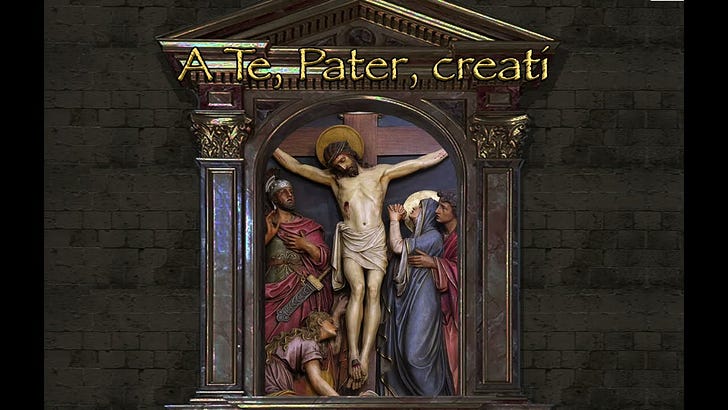As a convert to the Faith, I spent the first 10+ years only ever attending the Novus Ordo. It took some time before I learned about the Extraordinary Form, but no parishes offering it were close enough to where I lived at the time for me to experience it. More recently, after moving to a new state, I attended an Ordinariate parish for a few months. Its Divine Worship, which to be honest was incomparably more beautiful than even the most reverent Novus Ordo, used archaic English prayers based on those in the Anglican Book of Common Prayer, as well as traditional English hymns. Despite being Protestant, and corrected for any hint of error, these prayers and songs were profoundly beautiful and rich, particularly the “Humble Access,” “Comfortable Words” and – one of my favorite hymns – “O Sacred Head Surrounded.”
This week’s hymn (which will serve as a kind of “Lent in August,” following the “Christmas in July” tradition) is intended for the Lenten season. Although its musical form in Latin, German and then English was composed by Protestants, it is based on a medieval Latin poem, Salve mundi salutare, in which each stanza contemplated the different parts of Christ’s Body as it hung from the Cross. The final stanza, entitled Salve caput cruentatum, focused on His head crowned with thorns. This poem, possibly written either by St. Bernard of Clairvaux or Arnulf of Leuven in the 12th or 13th century, was adapted into a series of cantatas by the Danish Baroque composer Dieterich Buxtehude called Membra Jesu Nostri. Around this time, in the 17th century, it was translated into the German as O Haupt voll Blut und Wunden by the Lutheran hymnist Paul Gerhardt.
Though there have been many English versions, the one I heard at Divine Worship was O sacred head surrounded by crown of piercing thorn, written by Sir Henry Williams Baker, an Anglican vicar and proponent of the Oxford Movement, in 1861, whose hymnal included translations from the Roman Breviary and selections from St. John Henry Newman. As was common for Lutherans, the musical setting was adapted by Gerhardt from a secular song (in this case a courtly love song by Hans Leo Hassler), with melody arranged by Bach for his St. Matthew Passion.
Apart from the elegant, poetic Victorian English, this hymn is captivating for its somber contemplative quality, written from the perspective of a penitent addressing Christ on the Cross, pleading for the merits of His grace to come upon us and grant us the salvation He won. It is filled with a deep sorrow for Christ’s horrific sufferings, one which every human being besides the Blessed Virgin Mary has contributed to through our sins, lamenting the need for His agony, yet it also includes notes of hope peculiar for the Lenten season, acknowledging that “The glow of life decays, / Yet angel hosts adore you / And tremble as they gaze” and that, by our “happy fault,” as the Easter Exultet calls Adam and Eve’s original sin, Christ’s self-immolation has become the path to our divinization, demonstrating the power of God to transform even the worst evils into His greatest triumphs: “Beneath your cross abiding / For ever would I rest, / In your dear love confiding, / And with your presence blest.” Even as a Protestant hymn, with its beauty and profundity it far exceeds many modern Catholic songs used at Mass, as do many in the traditional English corpus.
Here is the English version from my favorite adaptation (slightly different from the one quoted above), performed by the Catholic YouTube family Clamavi De Profundis:
O sacred Head surrounded
By crown of piercing thorn!
O bleeding Head, so wounded,
Reviled and put to scorn!
Death's pallid hue comes o'er Thee,
The glow of life decays,
Yet angel hosts adore Thee
And tremble as they gaze.
What language shall I borrow
To thank Thee, dearest Friend,
For this, Thy dying sorrow,
Thy pity without end?
O make me Thine forever;
And should I fainting be,
Lord, let me never, never
Outlive my love for Thee.




